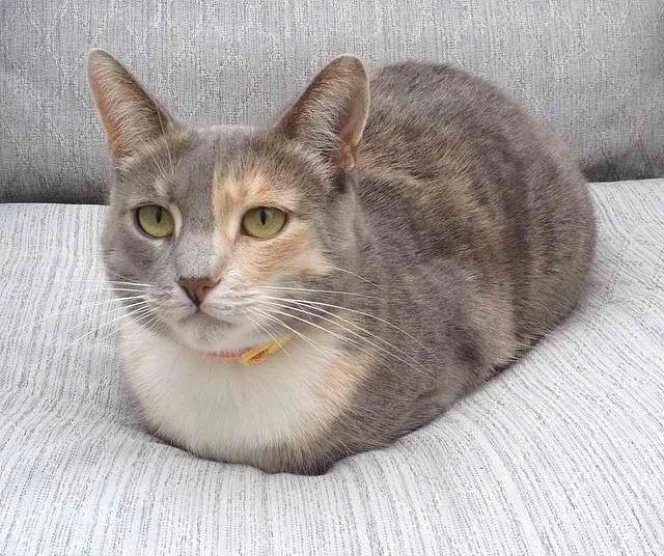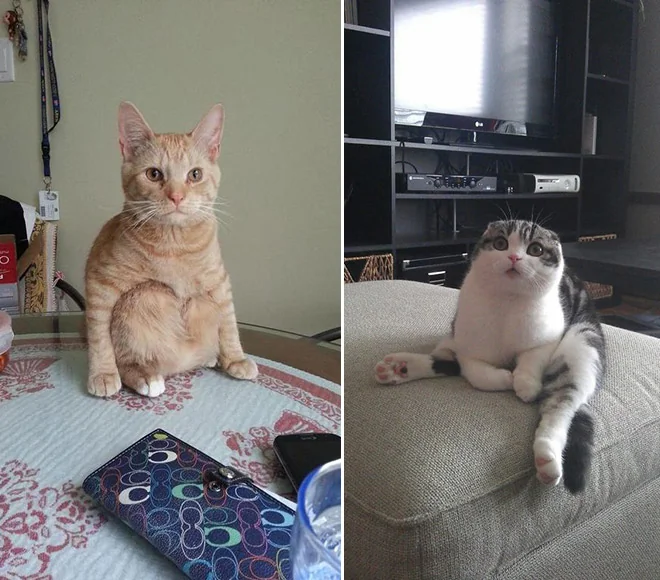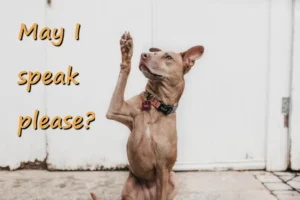Disclosure: We may earn a commission from helpful, relevant links in our content. No cost to you. See our privacy policy.
Welcome to the wacky world of feline sitting positions.
Cats are elegant, graceful creatures, until they’re not. Sometimes, they adopt positions that make us wonder if they forgot how to cat.
You’ve seen it—the twisted limbs, the head-tilting sprawl, the lovable loafing that leaves you scratching your head. This article is your go-to guide for understanding and enjoying these peculiarities.
We’re not just about to solve some of your feline mysteries; we’re about to add a dash of fun to your pet parent journey. Let’s dive in and untangle these kitty quirks together.

Why Does My Cat Sit in Such an Awkward Position?
Cats are natural contortionists. Their spine is more flexible than ours, and they have a few extra vertebrae, allowing them to adopt positions that might seem awkward or even uncomfortable to us.
These unique sitting positions can be a form of relaxation, an expression of comfort, or simply a display of their quirky personality. Your furry friend is not being weird; they’re just being a cat.
Understanding this is the first step in appreciating the wide range of cat postures you’ll come across.
What Does the ‘Splooting’ Position Mean?
Now onto a feline favorite – the ‘Splooting’ position. If your cat lays flat on their belly, stretching their hind legs out behind them like a supercat taking flight, they’re ‘Splooting.’

Cats sploot to cool down on a hot day, stretching out on a cool surface. It’s also a sign that they’re utterly relaxed, feeling safe, and at ease in their environment. While this posture is both cute and comical, it’s also a sign of your cat’s contentment.
So, next time you see your cat splooting, give yourself a pat on the back for providing such a comfortable home.
Is My Cat’s ‘Meatloaf’ Position Normal?
Indeed it is. The ‘Meatloaf’ position, or as some prefer to call it, the ‘loaf of bread’ position, is quite common among our feline friends. Here, your cat sits with their legs and tail tucked underneath their body, looking for all the world like a fresh-baked loaf of bread.

This position is a cat’s version of ‘casual comfort.’ It keeps their vital organs protected, allows for a quick escape if necessary, and provides a level of warmth, especially on cool surfaces.
If your cat ‘meatloafs’ often, it’s a sign of trust and contentment in their environment.
If your cat is a fan of the ‘meatloaf’ position, a heated cat bed like the K&H Thermo-Kitty Mat Heated Bed might be a perfect gift for them. Its gentle heat can provide additional comfort, especially during the cooler months.
How to Interpret Other Unique Cat Positions
Figuring out the feline body language can be both an interesting and challenging task. But learning about a few common positions can help you communicate more effectively with your cat, ensuring they’re comfortable and happy. Here are a few common cat positions:
- Belly-Up: If your cat is lying on their back, exposing their belly, it’s a sign of trust. This vulnerable position indicates they feel safe in their environment.
- Sitting on the Hind Legs: Occasionally, your cat might sit upright on their hind legs, meerkat style. They do this to get a better view of their surroundings.
- Curled Up Ball: When a cat is curled up tightly, with their tail wrapped around their body and their head tucked in, they’re trying to conserve heat. It might also indicate they’re feeling a bit anxious or uneasy.
- Crouched with Wide Eyes: This position signals fear or anxiety. Your cat is ready to run at any hint of danger.
- Lying Sideways: A relaxed, comfortable cat will often lie on their side, allowing for belly rubs. For cats that love to lie sideways, a scratcher lounge such as the PetFusion Ultimate Cat Scratcher Lounge offers a great space for relaxation, and it’s also a great tool for keeping their claws healthy
The key to interpreting your cat’s body language lies in observing the context and combining it with other signals, such as ear positioning, tail movement, and vocalization. Here’s a table of some of these positions for a quicker glance:
| Cat Position | Meaning |
| Belly-Up | Trust, contentment |
| Sitting on Hind Legs | Curiosity, alertness |
| Curled Up Ball | Conserving heat, potential unease |
| Crouched with Wide Eyes | Fear, anxiety |
| Lying Sideways | Relaxation, openness to social interaction |
As we like to say each time: every cat is unique. Your feline friend may have their own peculiar poses that aren’t listed here, and that’s okay. It’s all part of the fun and fascination of being a cat parent. Just look at this cat:

When Should I Worry About My Cat’s Sitting Position?
Your cat’s posture can be a window into their well-being.
While unique cat positions are typically normal and amusing aspects of their behavior, there are occasions when a change in posture can signal an underlying issue.
As a long-term feline behaviorist, I can tell you that any sudden shift in your cat’s sitting position warrants attention. If your cat typically sprawls out while sleeping and suddenly starts to ‘meatloaf’ persistently, this could indicate discomfort.
Similarly, a cat that usually presents the ‘meatloaf’ position but now continually ‘sploots’ might be trying to cool down due to overheating or feeling unwell. Pay attention to other signs, such as reduced appetite, changes in the litter box habits, or a drop in energy levels. If you notice these changes along with a shift in sitting position, it’s wise to consult a vet.
By observing these nuances in your cat’s behavior, you become a more proactive pet parent, and you could catch health issues early, making treatment more effective.

FAQs
Are some cat breeds more likely to sit weirdly?
Certain breeds have distinctive ways of sitting due to their physical structure. For example, Scottish Folds often sit in the “Buddha” position because of their unique skeletal structure.
Does my cat’s strange sitting mean they’re in pain?
Not always. Cats sit in odd positions for various reasons, most of which are perfectly normal. However, if accompanied by other signs of distress like loss of appetite or lethargy, it could indicate pain. There are certain cat body postures, though, that may indicate pain.
Why does my cat suddenly sit differently?
A sudden change in your cat’s sitting position could be due to several factors, ranging from a new-found comfort in the position, trying to cool down, or potentially indicating an underlying health issue.
Should I be worried if my cat sits with their back arched?
An arched back can be a defensive posture, or they might be stretching. However, if your cat frequently arches their back and seems uneasy or in distress, it’s a good idea to consult your vet.
Alex, a passionate animal lover, has experience in training and understanding animal behavior. As a proud pet parent to two dogs and three cats, he founded AnimalReport.net to share insights from animal experts and expand his knowledge of the animal kingdom.




